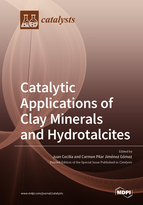Catalytic Applications of Clay Minerals and Hydrotalcites
A special issue of Catalysts (ISSN 2073-4344). This special issue belongs to the section "Catalytic Materials".
Deadline for manuscript submissions: closed (15 April 2021) | Viewed by 18061
Special Issue Editors
Interests: adsorption; biomass valorization; heterogeneous catalysis; high-added value products
Special Issues, Collections and Topics in MDPI journals
Interests: characterization; hydrotalcites; clay minerals; catalysis; biomass valorization
Special Issues, Collections and Topics in MDPI journals
Special Issue Information
Dear Colleagues,
Clay minerals are inexpensive and available materials with a wide range of applications (adsorbent, ion exchanger, support, catalyst, paper coating, ceramic, and pharmaceutical, among others). Clay minerals could be easily modified through acid/basic treatment, through the insertion of bulky ions or pillars in the interlayer spacing, as well as through acid treatment, improving their physicochemical properties.
Considering their low cost and high availability, clay minerals display a relatively high specific surface area in such a way that they have a great potential to be used as catalytic supports, since they can disperse expensive active phases as noble metals on the porous structure of their surface. In addition, the low cost of these supports allows their implementation on an industrial scale more easily than other supports, which are only feasible for the laboratory scale.
Hydrotalcites (considered as anionic or basic clays) are also inexpensive materials with a great potential to be used as catalysts, since their textural properties could also be modified easily through the insertion of anions in their interlayer spacing. In the same way, these hydrotalcites, formed by layered double hydroxides, can lead to their respective mixed oxides after thermal treatment. These mixed oxides are considered basic catalysts with a high surface area, so they can also be used as catalytic support.
Taking into account the great potential of clay minerals and hydrotalcites, the editors think that the catalytic applications of both materials are worthy of a Special Issue in the journal Catalysts.
Dr. Juan Antonio Cecilia
Dr. Carmen Pilar Jiménez Gómez
Guest Editors
Manuscript Submission Information
Manuscripts should be submitted online at www.mdpi.com by registering and logging in to this website. Once you are registered, click here to go to the submission form. Manuscripts can be submitted until the deadline. All submissions that pass pre-check are peer-reviewed. Accepted papers will be published continuously in the journal (as soon as accepted) and will be listed together on the special issue website. Research articles, review articles as well as short communications are invited. For planned papers, a title and short abstract (about 100 words) can be sent to the Editorial Office for announcement on this website.
Submitted manuscripts should not have been published previously, nor be under consideration for publication elsewhere (except conference proceedings papers). All manuscripts are thoroughly refereed through a single-blind peer-review process. A guide for authors and other relevant information for submission of manuscripts is available on the Instructions for Authors page. Catalysts is an international peer-reviewed open access monthly journal published by MDPI.
Please visit the Instructions for Authors page before submitting a manuscript. The Article Processing Charge (APC) for publication in this open access journal is 2700 CHF (Swiss Francs). Submitted papers should be well formatted and use good English. Authors may use MDPI's English editing service prior to publication or during author revisions.
Keywords
- Caracterization
- Clay mineral
- Hydrotalcites
- Mixed oxides
- Catalytic support
- Heterogeneous catalysis







